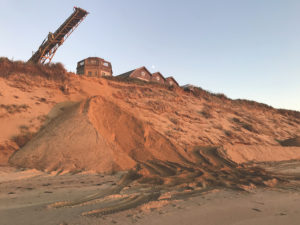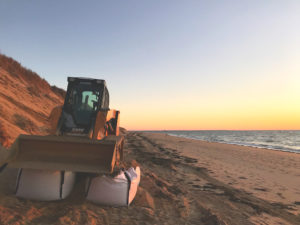WELLFLEET — The Blasch property is receiving another massive amount of “sacrificial sand” in an effort to stall the mansion’s collapse over the edge of a coastal bank.

The 5,817-square-foot house perched on “the Gut,” a narrow spit of sand between Cape Cod Bay and the Herring River, was only 25 feet from the edge of the bluff one year ago. The owners, Barbara and Mark Blasch, are engaged in a legal battle with the town’s conservation commission, which last year denied them permission to erect a 241-foot stone seawall to shore up the coastal bank beneath their house.
The Blasches’ attorneys are appealing that denial in a case pending in Barnstable Superior Court. In the meantime, the owners are adding lots of sand to the cliff for the second time this year.
In January the conservation commission allowed them to add between 1,000 and 2,000 cubic yards of sand to the rapidly eroding bayside bluff. Last month the Blasches notified the town that they were going to dump a similar amount there. That work has begun, said Hillary Greenberg-Lemos, Wellfleet’s health and conservation agent on Tuesday.
The property owners have been adding sand there since 2013, when they first got permission to repair their beach stairway, add plantings, and renourish the coastal bank. The town did not impose limitations on the amount of sand. But 1,000 to 2,000 cubic yards is by far the most ever added at one time, Greenberg-Lemos said.
The sand is “sacrificial,” she explained, meaning it is being used to prevent further landward erosion. It is meant to be a temporary barrier that will be taken away by wave action.
Usually sand is added as part of the conditions to build a seawall. It replaces sand that would otherwise be available to the beach if there were no seawall in place, Greenberg-Lemos said. It’s also taken away by wave action but much more slowly.
Sand nourishment does serve a purpose, she said, though this particular use of it at the Blasch house is not typical.

When members of the conservation commission received notice in October that the Blasches were bringing in more sand, they asked their representatives to attend the commission’s Nov. 6 meeting. The encounter was apparently contentious, said Greenberg-Lemos, though she was not in attendance.
But since the ConCom has not agreed to be video recorded by the town, there is an only an audio tape of the meeting. This was not available by the Independent’s deadline. And the members of the ConCom have refused to talk about the case because of the ongoing litigation.
Greenberg-Lemos said some members of the conservation commission are emotional about this particular project. The fact is, the town cannot stop the massive new sand infusion because there was never a limit on the amount of sand to be added; also the method of adding the larger amount of sand had already been approved in January.
As of last week there was a large vehicle acting as a conveyor belt shooting sand from the Blasches’ back yard to the bottom of the bank. And a small tracker loader was on the beach moving the sand around.
“It’s a more intense way of moving the sand” than the way Gordon Peabody did it for the Blasches back in 2013 when he just dumped it over the edge of the cliff, Greenberg-Lemos said.
The Blasch house is truly on the edge. In October 2018 engineer John Harrison warned the that the house was in danger of “complete collapse.”
The Blasches’ consultants told the ConCom that the house could not be moved because of the steepness of the property and the location of geothermal wells and a septic field, and because “there is not enough land to relocate the dwelling and maintain compliance with zoning setbacks and property line encroachments.”



